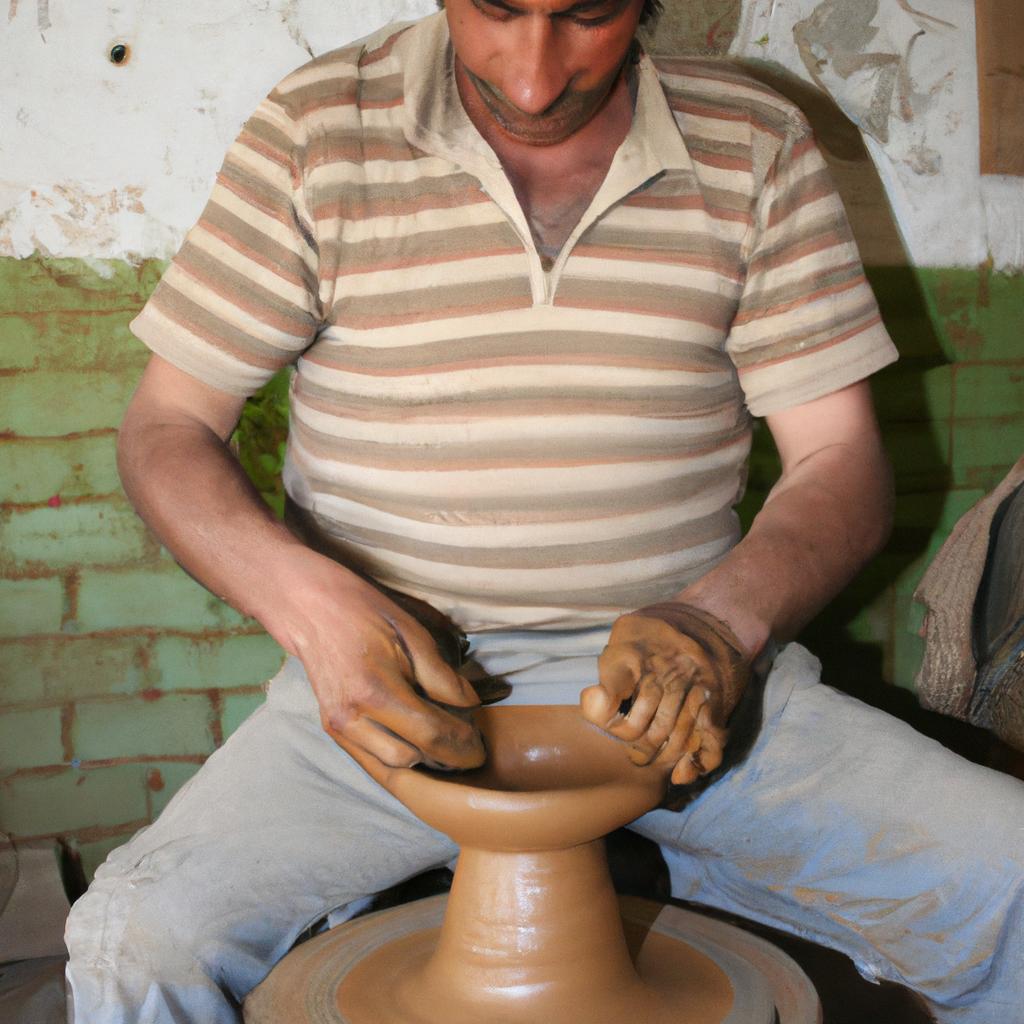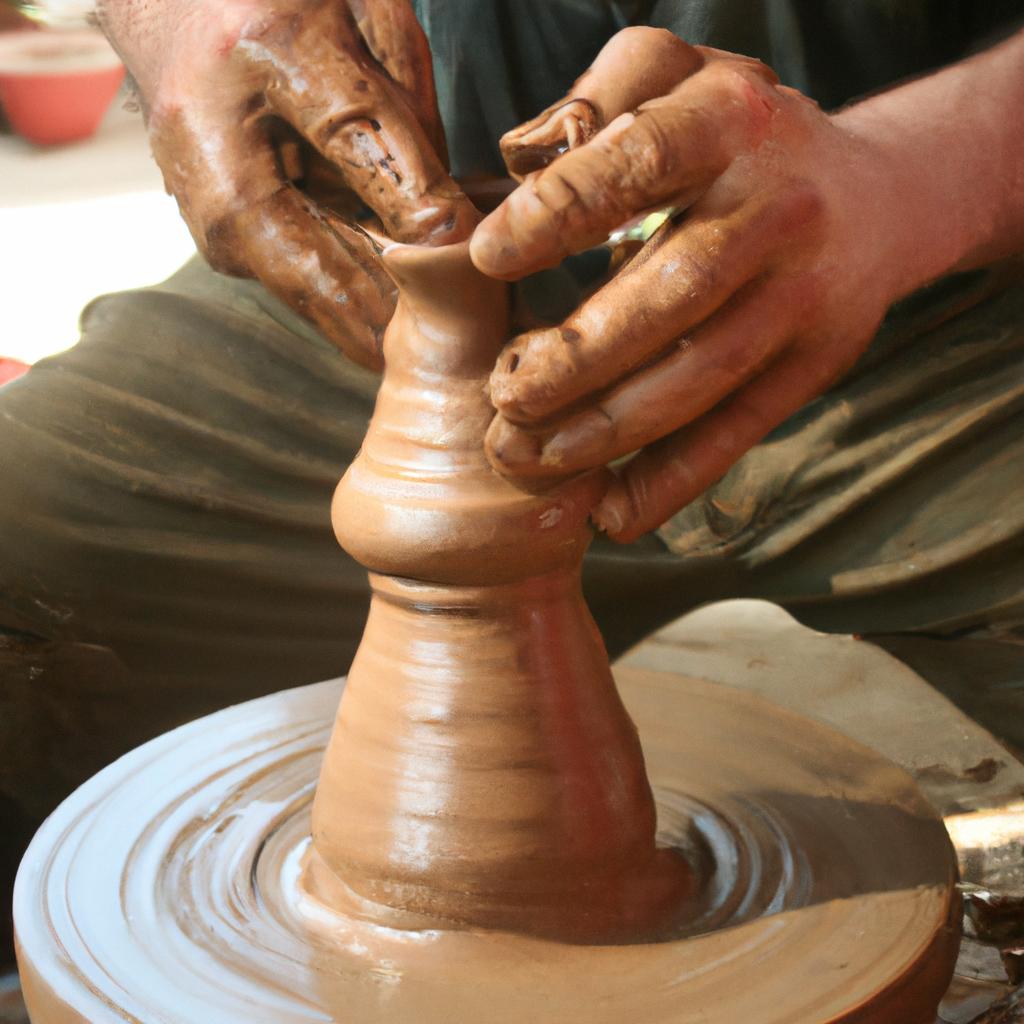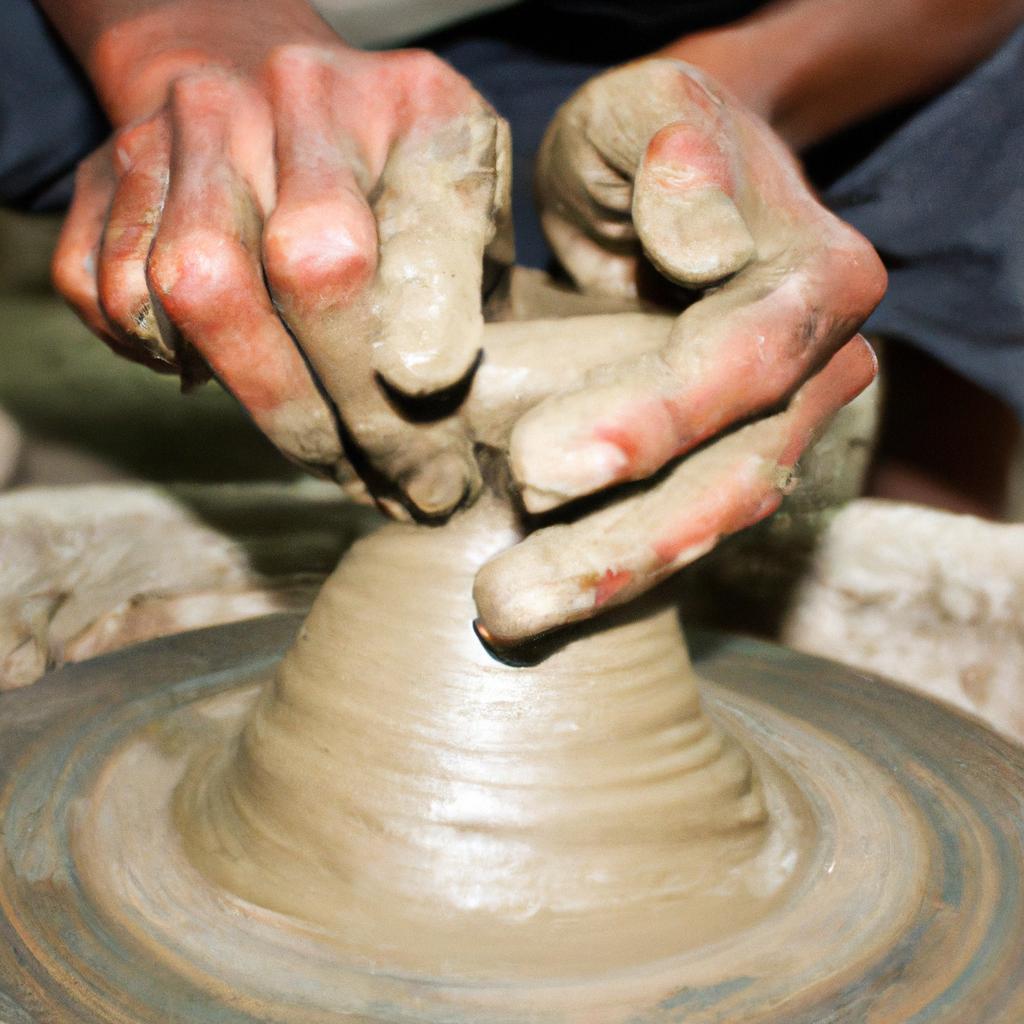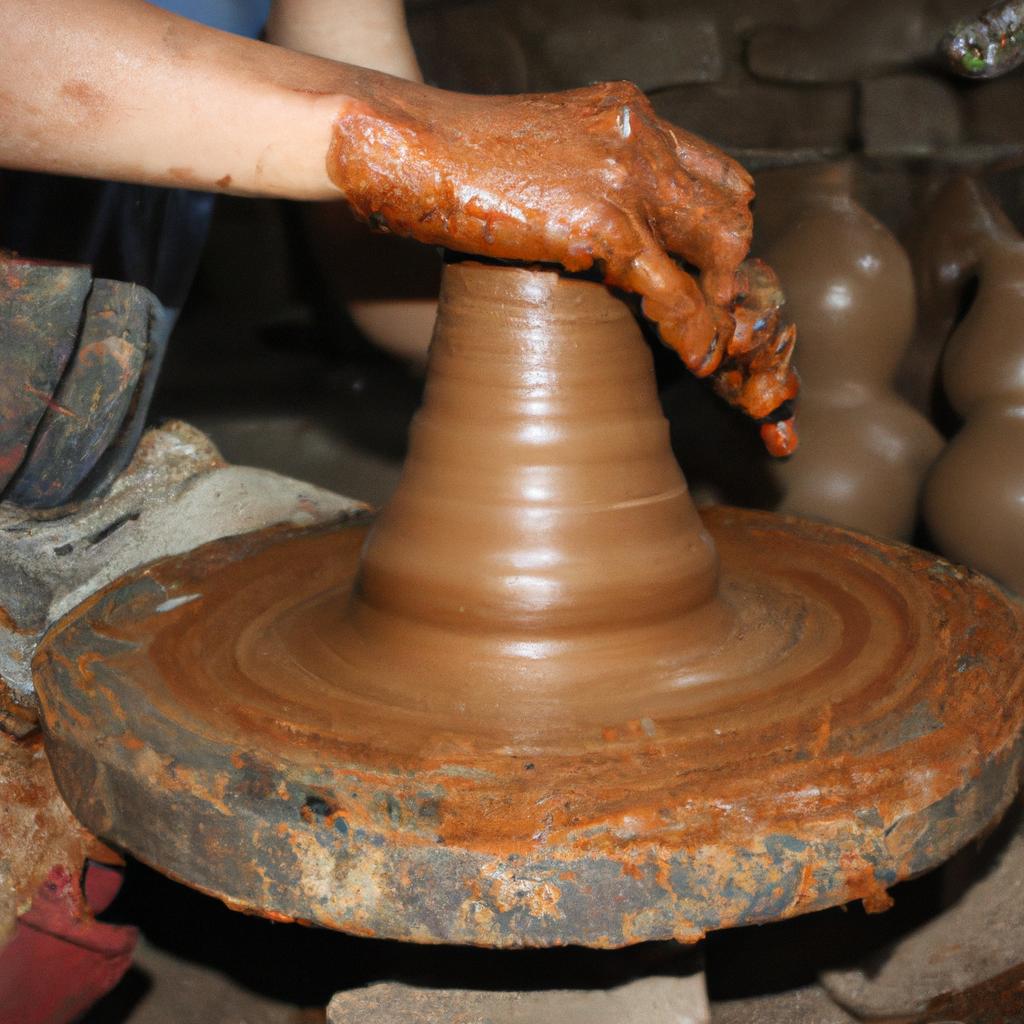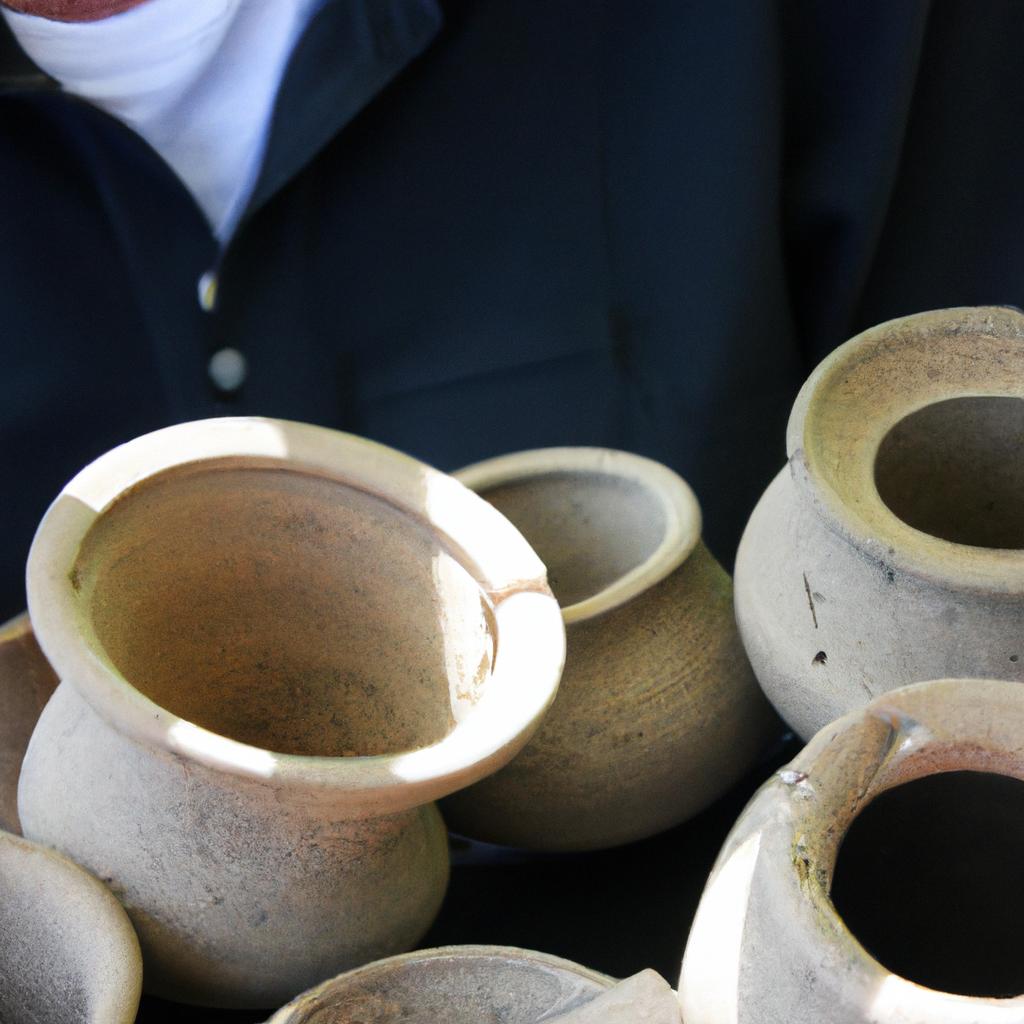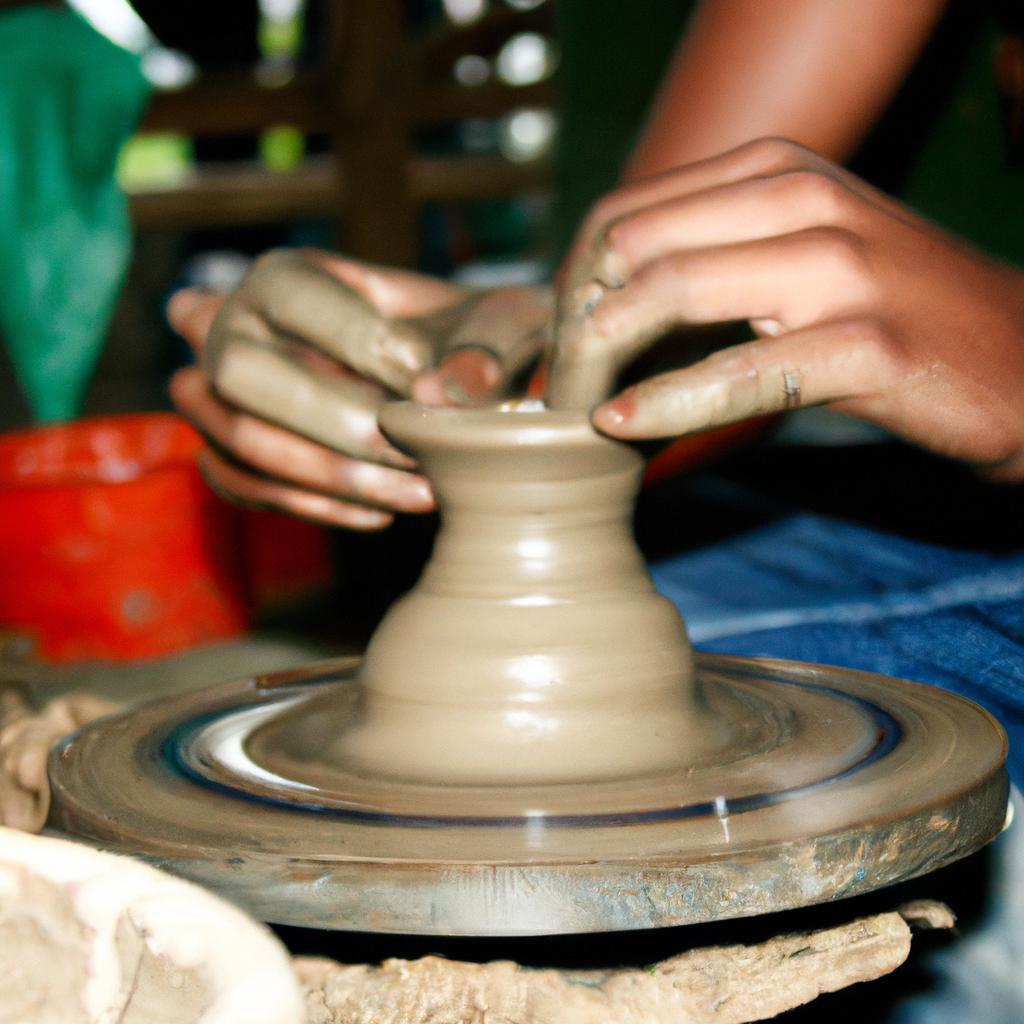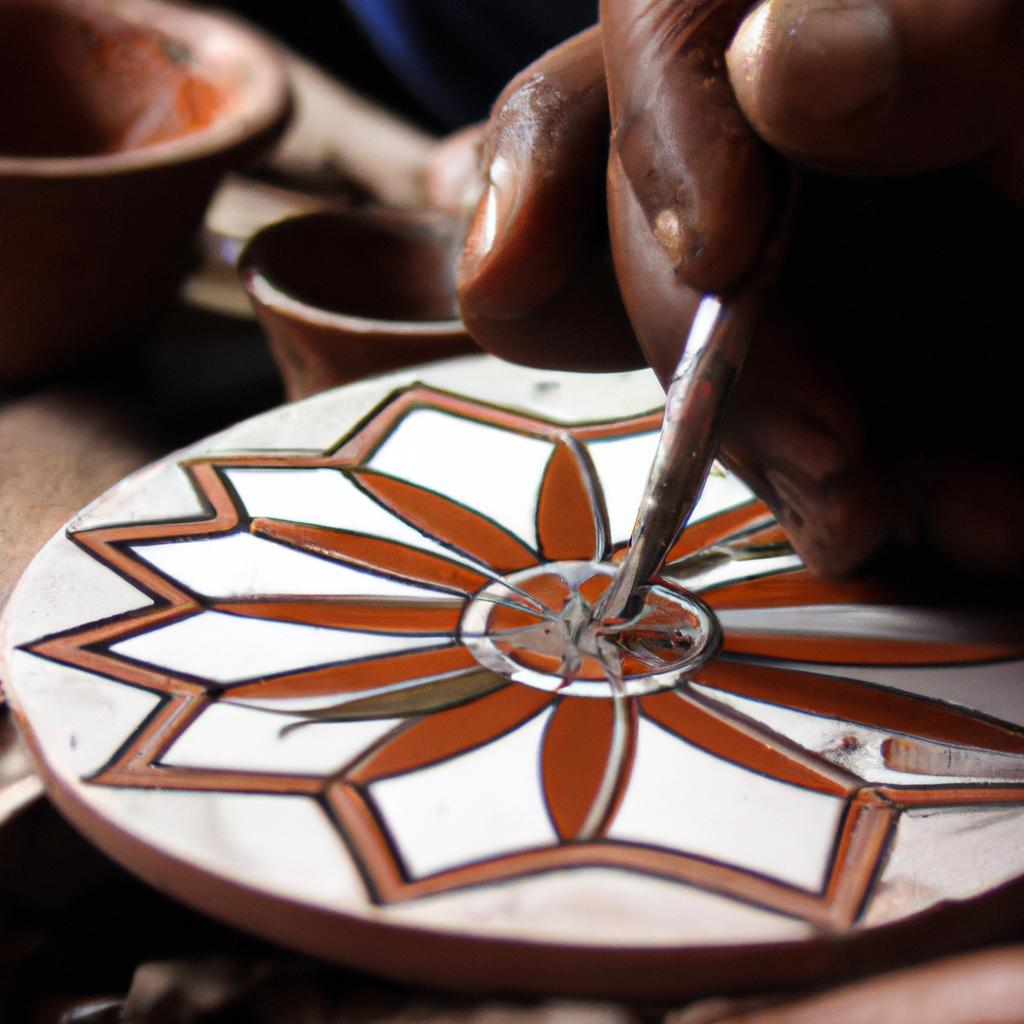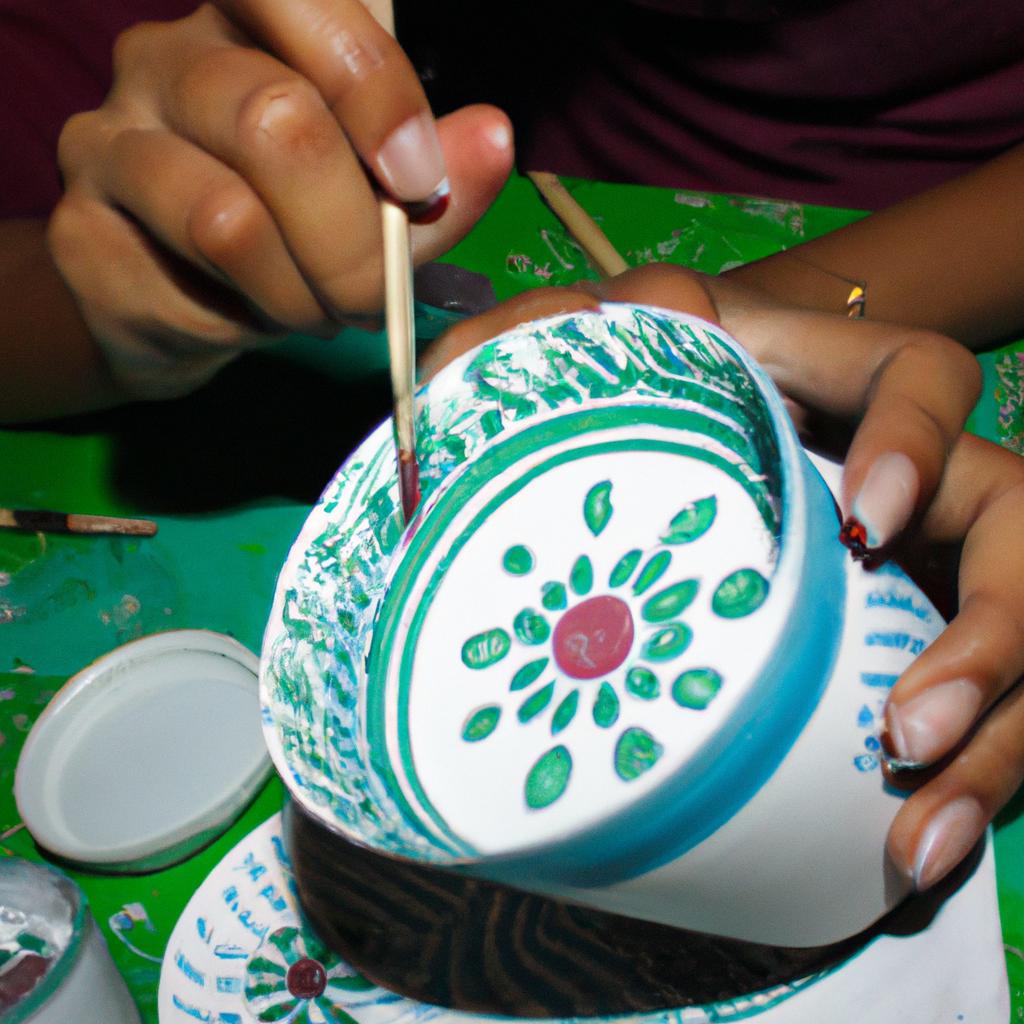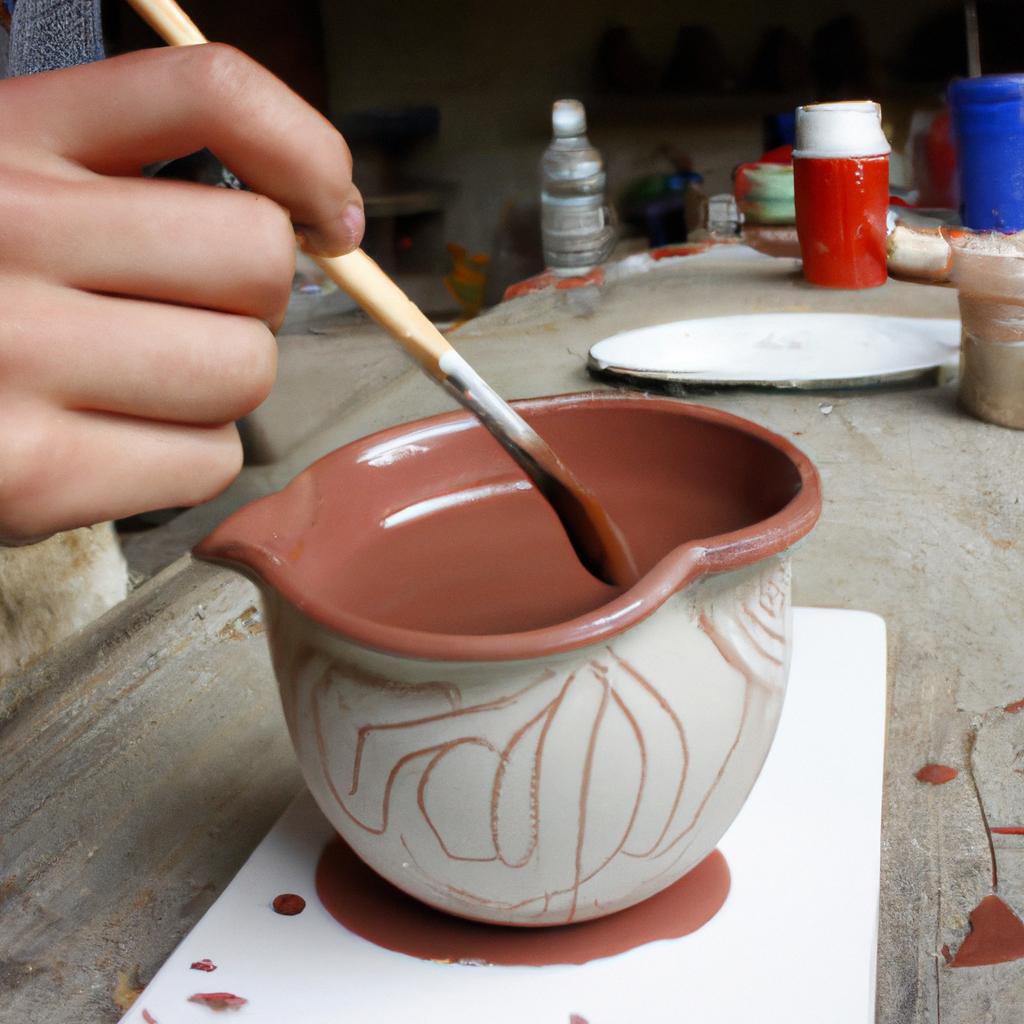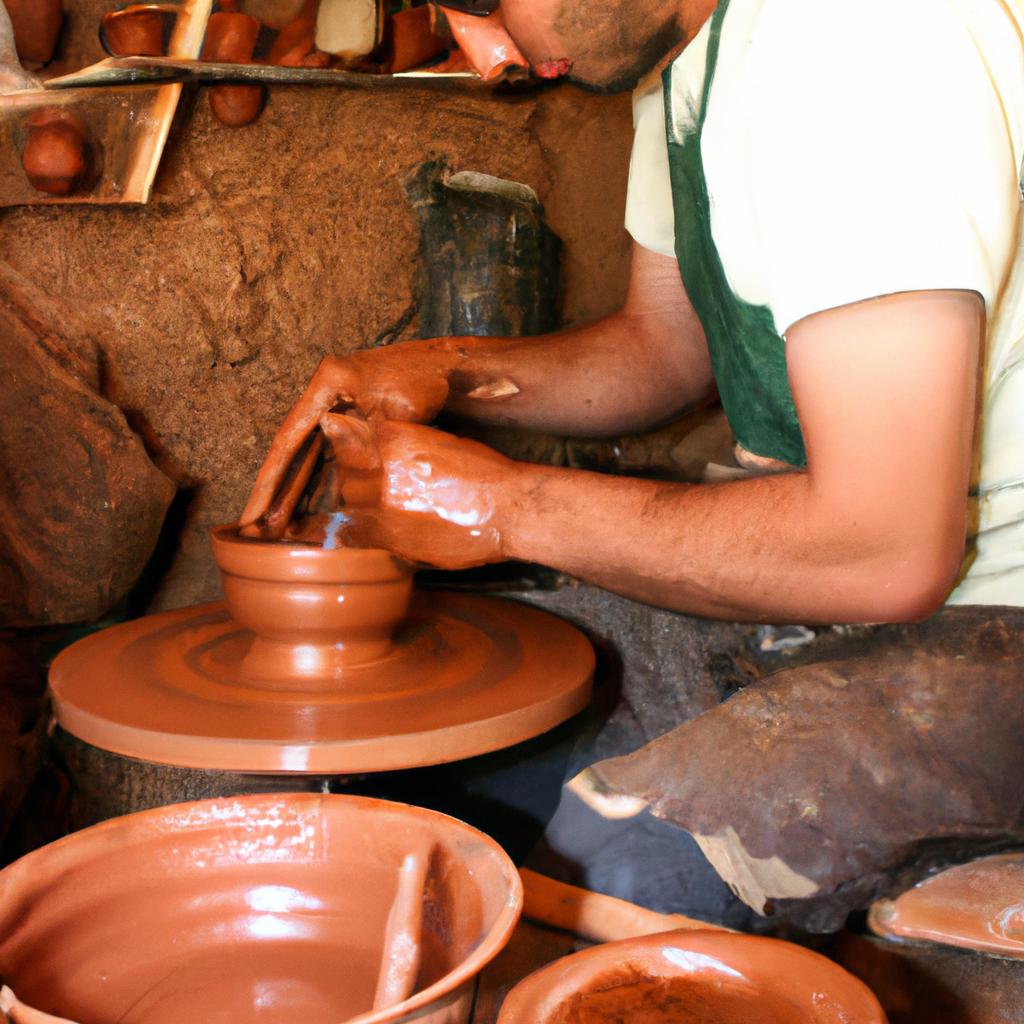Lustre pottery, renowned for its iridescent metallic glazes and intricate designs, has a rich historical background that traces back to ancient civilizations. Exploring the origins of lustre pottery provides valuable insight into the cultural exchanges and technological advancements of different eras. For instance, let us consider the case study of Moorish Spain during the 14th century. The exquisite lustreware produced in this region not only exemplifies the artistic sophistication achieved by Islamic craftsmen but also highlights their mastery over innovative firing techniques.
The fascinating beginnings of lustre pottery can be traced back to Mesopotamia around 9th century AD, where it emerged as a result of cross-cultural interactions between Persians and Arabs. This unique art form gained prominence through its distinctive use of metallic oxides mixed with glazes to produce shimmering effects on ceramics. Although originally inspired by Persian traditions, lustre pottery evolved significantly under various influences throughout history. Notably, Moorish Spain became an epicenter for further experimentation and refinement of this technique during the Middle Ages.
By examining the historical origins of lustre pottery through examples such as Moorish Spain’s contributions, we gain a deeper understanding of how this captivating art form flourished across cultures and time periods. Furthermore, Furthermore, studying the technological advancements and artistic innovations in lustre pottery allows us to appreciate the ingenuity and craftsmanship of ancient civilizations. For instance, Moorish potters in Spain developed sophisticated firing techniques such as reduction firing, where oxygen is restricted during the final stages of firing to produce metallic effects on the glazes. This level of technical expertise demonstrates the dedication and skill of these artisans in pushing the boundaries of ceramic art.
Moreover, exploring lustre pottery’s historical background invites us to reflect on the cultural exchanges that occurred throughout history. The transmission of knowledge and techniques from one civilization to another played a significant role in shaping this art form. Islamic craftsmen, for example, contributed their expertise in lustreware production to various regions they encountered during their expansion across Europe and Asia. As a result, lustre pottery became not only a symbol of artistic excellence but also a testament to the interconnectedness of different cultures.
In conclusion, delving into the historical origins and cultural significance of lustre pottery provides valuable insights into its development as an art form. From Mesopotamia to Moorish Spain and beyond, this technique has evolved and thrived thanks to cross-cultural influences and technological advancements. By studying these aspects, we can gain a deeper appreciation for lustre pottery’s beauty and understand its broader historical context.
Early forms of decorative pottery
Early forms of decorative pottery can be traced back to ancient civilizations, where artisans crafted vessels that were not only functional but also visually appealing. One fascinating example is the lustre pottery, which originated in the Islamic world during the 9th century. The development and popularity of lustre pottery marked a significant shift in ceramic production techniques and aesthetics.
Lustre pottery was known for its distinctive metallic sheen, achieved through a complex process involving glazes containing metal oxides such as silver or copper. These glazes were applied to the surface of clay vessels before firing them at high temperatures. Once fired, the metal oxides would react with oxygen, producing a lustrous effect that ranged from golden to iridescent hues.
To understand the significance of lustre pottery’s emergence, it is crucial to examine early forms of decorative pottery that preceded it. Prior to the advent of lustreware, ceramics were primarily decorated using methods like incising or painting patterns directly onto the vessel’s surface. While these techniques allowed for intricate designs, they lacked the luminosity and depth offered by lustreware.
The introduction of lustre pottery revolutionized ceramic design by introducing new possibilities for creating richly ornamented objects. This advancement not only elevated the aesthetic value of pottery but also expanded its cultural significance, leading to an increased demand for luxurious tableware among elite social classes.
- Exquisite craftsmanship: Lustre pottery showcased exceptional artistry and attention to detail.
- Opulent appearance: Its shimmering surfaces and vibrant colors added a touch of opulence to domestic environments.
- Symbolic motifs: Many lustreware pieces featured symbolic motifs inspired by nature, mythology, or religious themes.
- Trade and globalization: The widespread distribution of lustre pottery across different regions facilitated cultural exchange and trade networks.
Markdown format table:
| Characteristics | Examples |
|---|---|
| Elaborate geometric patterns | Symmetrical designs featuring intricate interlocking shapes |
| Calligraphic inscriptions | Arabic script used to convey religious or poetic messages |
| Floral and vegetal motifs | Depictions of flowers, leaves, and vines in various styles |
| Figurative representations | Human figures, animals, and mythical creatures depicted in lively poses |
In conclusion, the emergence of lustre pottery marked a significant milestone in the history of decorative ceramics. Its introduction brought about a shift in production techniques and aesthetics, revolutionizing the way pottery was perceived and valued. The next section will explore the influences from ancient Mesopotamia that shaped the development of lustre pottery during this period.
Influences from ancient Mesopotamia
From the early forms of decorative pottery, we now turn our attention to the influences that ancient Mesopotamia had on the development of lustre pottery. To illustrate this influence, let us consider a hypothetical case study where a skilled potter in ancient Mesopotamia introduces metallic glazes into their ceramic artwork.
The utilization of metallic glazes marked a significant advancement in pottery craftsmanship during this period. By incorporating elements such as copper and silver oxides into their glazes, potters were able to achieve stunning effects characterized by iridescence and a lustrous sheen. These innovative techniques quickly spread throughout Mesopotamia, captivating both artisans and patrons alike.
To fully grasp the impact of these developments, it is essential to explore four key aspects:
-
Technological Advancements: The introduction of kilns equipped with precise temperature controls allowed for more controlled firing processes. This enabled potters to achieve consistent results when applying metallic glazes and enhanced their ability to create intricate designs.
-
Cultural Exchange: Ancient Mesopotamia served as a vibrant hub for trade and cultural exchange, facilitating the dissemination of knowledge regarding metallurgy and ceramics. As neighboring civilizations interacted with Mesopotamian artisans, they too began experimenting with metallic glazes in their own pottery traditions.
-
Aesthetic Influences: The artistic sensibilities prevalent in ancient Mesopotamian society heavily influenced the design choices made by potters working with lustre techniques. Motifs inspired by nature, mythology, and religious symbolism adorned many pieces, reflecting the cultural values and beliefs of the time.
-
Economic Significance: Lustre pottery became highly sought after not only for its aesthetic appeal but also due to its value as an export commodity. It played a crucial role in shaping regional economies by contributing significantly to trade networks spanning across various civilizations within and beyond Mesopotamia.
By delving into these factors through an interdisciplinary lens, we gain a deeper understanding of how the advent and proliferation of lustre pottery impacted ancient societies. The next section will explore the subsequent developments in lustre glazes, shedding light on the continued evolution of this remarkable art form.
Transitioning into the subsequent section about the “Development of lustre glazes,” we witness a captivating journey that builds upon these early influences, further refining techniques and expanding artistic possibilities.
Development of lustre glazes
The ancient land of Mesopotamia, with its rich history and cultural heritage, played a pivotal role in shaping the development of lustre pottery. One prime example is the city of Babylon, where skilled artisans experimented with various techniques to create stunning ceramic pieces adorned with intricate designs. This exploration led them to discover the mesmerizing effects of metallic lustres – a technique that would become synonymous with lustre pottery.
To fully understand the influence of ancient Mesopotamia on lustre pottery, it is important to delve into some key aspects:
-
Artistic Inspiration:
- The elaborate jewelry and metalwork found within Mesopotamian tombs inspired artists to replicate these shimmering qualities on ceramics.
- Motifs such as mythical creatures, religious symbols, and geometric patterns were commonly used in both metalwork and later adapted for lustre pottery.
-
Technological Advancements:
- Ancient Mesopotamians developed advanced kiln technology that allowed for controlled firing processes essential for achieving the desired lustrous effect.
- They also discovered new glazing materials like tin oxide and silver chloride, which enhanced the reflective properties of their ceramics.
-
Trade Routes:
- The strategic location of Mesopotamia facilitated extensive trade networks that spread across different regions.
- Ceramic wares decorated with lustre techniques became highly sought after commodities throughout the Mediterranean world due to their uniqueness and aesthetic appeal.
-
Cultural Exchange:
- As empires rose and fell, conquests brought about cultural exchanges between civilizations.
- These interactions allowed for knowledge sharing and cross-pollination of artistic ideas, influencing the development of lustre pottery practices beyond just Mesopotamia’s borders.
Table: Lustrous Pottery Techniques in Ancient Mesopotamia
| Technique | Description |
|---|---|
| Metallic Lustres | Application of metallic compounds (such as gold and silver) onto the glazed surface for reflection |
| Tin Oxide Glazes | Use of tin oxide to create opaque white glazes |
| Silver Chloride | Incorporation of silver chloride for a yellowish or amber luster |
| Firing Techniques | Controlled kiln firing methods to achieve desired lustre effects |
Such influences from ancient Mesopotamia laid the foundation for further experimentation and development in lustre pottery. As we move forward, we will explore how these techniques evolved during the Islamic Golden Age and became an integral part of cultural expression.
Now, let us delve into the fascinating world of the Islamic Golden Age and its significant contributions to lustre pottery.
Islamic Golden Age and lustre pottery
Transitioning from the previous section’s exploration of lustre glazes, we now delve into the captivating era known as the Islamic Golden Age and its profound impact on the development and refinement of lustre pottery techniques. To better comprehend this influence, let us consider a hypothetical case study involving a skilled potter named Hasan.
Hasan, an artisan living during the Islamic Golden Age in 10th century Persia, sought to push the boundaries of his craft by experimenting with new glazing methods. Inspired by his cultural surroundings and access to innovative materials, he embarked on a journey that would forever shape the world of pottery. Aided by advancements in chemistry and alchemy, Hasan meticulously formulated unique lustre glazes using metallic oxides such as copper or silver.
During this transformative period, several factors contributed to the flourishing popularity of lustre pottery within Islamic societies:
-
Technological Advancements: The Islamic Golden Age saw significant advancements in various fields including ceramics technology. Potters like Hasan were able to benefit from improved kiln designs and temperature control which allowed for more precise firing processes essential in achieving desired lustrous effects.
-
Cultural Exchange: Islam fostered extensive trade routes across diverse regions, enabling cultural exchange between different civilizations. As knowledge spread throughout these networks, so too did artistic influences and techniques related to lustre pottery. This cross-pollination led to innovation as potters incorporated elements from Persian, Byzantine, and Chinese ceramic traditions into their own works.
-
Patronage & Prestige: Wealthy patrons during the Islamic Golden Age recognized both the artistic beauty and technical prowess displayed in lustre pottery creations. These individuals commissioned highly skilled artisans like Hasan to produce exquisitely crafted pieces adorned with intricate designs reflecting their social status and refined taste.
-
Symbolism & Spirituality: Lustre pottery held symbolic significance within Islamic societies. The shimmering metallic glazes were often associated with the divine and used in religious contexts, such as creating vessels for storing holy water or decorating mosques. This imbued lustre pottery with a spiritual aura that resonated deeply within the hearts of believers.
Table: Notable Lustre Pottery Techniques during the Islamic Golden Age
| Technique | Description | Example Usage |
|---|---|---|
| Honeycomb Pattern | Intricate geometric designs resembling honeycombs achieved through precise application of multiple lustre layers | Decorative tiles adorning palace interiors |
| Calligraphic Motifs | Elegant incorporation of Arabic calligraphy into lustre-painted designs | Inscriptions on ceramics conveying verses from the Quran |
| Animal Imagery | Depictions of animals, both real and mythical, rendered using lustrous glazes | Bowls adorned with phoenixes symbolizing rebirth and immortality |
| Floral Patterns | Elaborate floral motifs highlighting delicate petals and blossoms | Vases embellished with vibrant tulips and roses |
Transitioning seamlessly to our next section exploring the spread of lustre pottery in Europe, we witness how this mesmerizing art form continued to captivate audiences beyond Islamic societies.
Spread of lustre pottery in Europe
Section H2: Spread of Lustre Pottery in Europe
After the flourishing of lustre pottery during the Islamic Golden Age, its mesmerizing allure began to captivate European artisans and collectors alike. One notable example is that of Antonio da Sangallo the Younger, an Italian architect who incorporated lustreware tiles into his design for the Villa Madama in Rome. This integration highlights how this distinctive ceramic technique transcended borders and found its way into diverse artistic expressions across different regions.
The appeal of lustre pottery gradually spread throughout Europe, leading to a surge in its production and consumption. Its popularity can be attributed to several factors:
-
Aesthetic Appeal: The shimmering metallic sheen created by the application of precious metals such as gold or silver gave lustreware a unique visual quality that fascinated both artists and connoisseurs.
-
Exoticism: As trade routes expanded and cultural exchanges intensified, Europeans developed a fascination with Eastern art forms. Lustre pottery from the Middle East was seen as exotic and became highly sought after, symbolizing wealth and sophistication.
-
Technological Advancements: European potters recognized the technological advancements made by their counterparts in the Islamic world. They eagerly adopted these techniques, which enabled them to produce their own versions of lustreware.
-
Royal Patronage: The patronage of royalty played a significant role in popularizing lustre pottery among European elites. Monarchs collected beautiful examples of this exquisite ceramic ware, further fueling its desirability among the upper classes.
To illustrate the widespread influence of lustre pottery in Europe during this period, consider Table 1 below:
Table 1: Examples of Notable Lustre Pottery Centers in Europe
| Country | Center | Influences |
|---|---|---|
| Italy | Gubbio | Persian and Hispano-Moresque |
| Spain | Manises | Islamic and Italian Renaissance |
| England | Liverpool | Dutch and Persian |
| France | Nevers | Italian, Spanish, and Ottoman |
This table showcases how lustre pottery centers in various European countries were influenced by different artistic traditions. The cross-pollination of ideas and techniques resulted in the creation of unique regional styles that added to the richness of Europe’s ceramic heritage.
As we delve into the contemporary revival of lustre pottery, it is essential to recognize the lasting impact this art form had on European ceramics. Its diffusion across borders not only enriched local craftsmanship but also paved the way for further innovations in ceramic production techniques.
Contemporary revival of lustre pottery
Historical Origins: Lustre Pottery and Its Fascinating Beginnings
Spread of Lustre Pottery in Europe:
Having explored the origins and early development of lustre pottery, we now turn our attention to its spread throughout Europe. One particularly noteworthy case study is the influence of Islamic ceramic traditions on lustre pottery production in Spain during the 13th century.
During this period, Spanish potters in Valencia and Malaga began adopting techniques from their Moorish neighbors, who had inherited a rich tradition of lustreware from Persia and Egypt. This cross-cultural exchange resulted in the creation of exquisite pieces that incorporated intricate geometric patterns and vibrant hues. The fusion of Islamic motifs with local Spanish designs proved immensely popular, leading to an increased demand for lustre pottery across Europe.
The dissemination of lustre pottery can be attributed to several key factors:
-
Trade networks: As trade routes expanded during the medieval era, merchants played a crucial role in facilitating the distribution of luxury goods. Lustre pottery, being highly valued among elite circles for its beauty and craftsmanship, found its way into palaces, cathedrals, and wealthy households across Europe.
-
Royal patronage: European monarchs recognized the prestige associated with owning fine ceramics and actively supported workshops producing lustreware. By commissioning skilled artisans or importing these wares directly, kings and queens helped fuel the popularity of lustre pottery among nobility.
-
Technological advancements: The development of new kiln technologies allowed potters to achieve higher temperatures required for successful glaze application. With improved firing techniques, lustre effects became more pronounced and visually striking, further enhancing the allure of these artworks.
-
Aesthetics and symbolism: Lustre pottery appealed not only due to its aesthetic appeal but also because it symbolized wealth, sophistication, and cultural connections with distant lands. Owning such objects served as status symbols for European elites seeking to display their refined taste and cosmopolitan sensibilities.
Table: Influences on the Spread of Lustre Pottery in Europe
| Factors | Description | Impact |
|---|---|---|
| Trade networks | Expansion of trade routes facilitated the distribution of lustre pottery across Europe. | Increased |
| Royal patronage | Monarchs actively supported workshops producing lustreware, contributing to its popularity among nobility. | Promoted |
| Technological advancements | Improved kiln technologies allowed for better glaze application, resulting in more visually striking lustre effects. | Enhanced |
| Aesthetics and symbolism | Lustre pottery symbolized wealth, sophistication, and cultural connections with distant lands, appealing to elites. | Status |
In summary, the spread of lustre pottery throughout Europe was a result of trade networks, royal patronage, technological advancements, and the aesthetic appeal it held for European elites. By examining such factors, we gain a deeper understanding of how this art form became integral to both artistic expression and social status during the medieval period.


